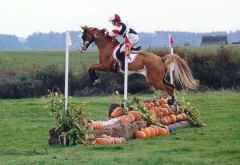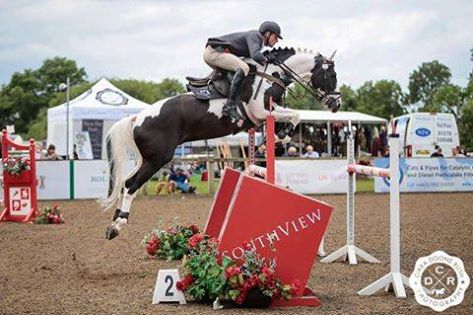Exmoor Pony
The Exmoor pony is a horse breed native to the British Isles, where some still roam as semi-feral livestock on Exmoor, a large area of moorland in Devon and Somerset in southwest England. The Exmoor is one of the British Isles mountain and moorland pony breeds, having conformation similar to that of other cold-weather pony breeds. They are hardy and used for many activities, as well as contributing to the conservation and management of several natural pasture habitats. Ponies were first mentioned in Exmoor in 1086, though a breed society was not formed until 1921. The breed nearly became extinct following World War II, and today is at "critical" status by the Equus Survival Trust, with a worldwide population of about 800 animals, with between 100 and 300 active adult breeding mares in existence.The Exmoor pony is strong for its height, with heavy, dense bone and powerful musculature, and is noted for its hardiness, disease-resistance, and endurance. it shows a distinctly different jaw structure to other horse breeds, including the beginnings of development of a seventh molar.
The head is somewhat large in proportion to the body, with small ears, and has a characteristic "toad eye" caused by fleshiness of the eyelids, which helps both to deflect water and provide extra insulation. As with most cold-weather pony breeds, the Exmoor grows a winter coat consisting of a highly insulative woolly underlayer and a top-coat of longer, oily hairs which prevent the undercoat from becoming waterlogged by diverting water down the sides of the animal to fall from just a few drip areas. The mane and tail are thick and long, and the dock of the tail is of a type common in cold-weather ponies, having coarse white hairs, known variously by terms such as "frost cap," or "snow chute," which deflect rainwater away from the groin and underbelly areas to fall from the long hairs on the back of the hindleg.
Exmoor ponies are usually brown, with Pangaré ("mealy") markings[3] around the eyes, muzzle, flanks and underbelly. Pangaré markings occur in other equines as well as horses, and are considered to be a primitive trait. Entry in the breed registry requires that the animal have no white markings and is not too tall. They usually stand 11.1 to 12.3 hands (45 to 51 inches, 114 to 130 cm), with the height limit for mares being 12.2 hands (50 inches, 127 cm) and that for stallions and geldings 12.3 hands (51 inches, 130 cm).
Exmoors that are not feral are used for a variety of activities, including showing, jumping, long-distance riding, and driving. The breed's hardiness makes it suitable for conservation grazing, and it contributes to the management of many heathland, chalk grassland and other natural pasture habitats, as well as to the conservation of Exmoor itself.
Buy the latest equestrian fashion brands from the satableexpress on line shop, offering quality equine brands at low low prices delivered to your door. Stableexpress equestrian database find equestrian websites from around the world - Stableexpress equestrian website portal news articles and information for horse and pony health product riding products equestrian business directory search ... -






